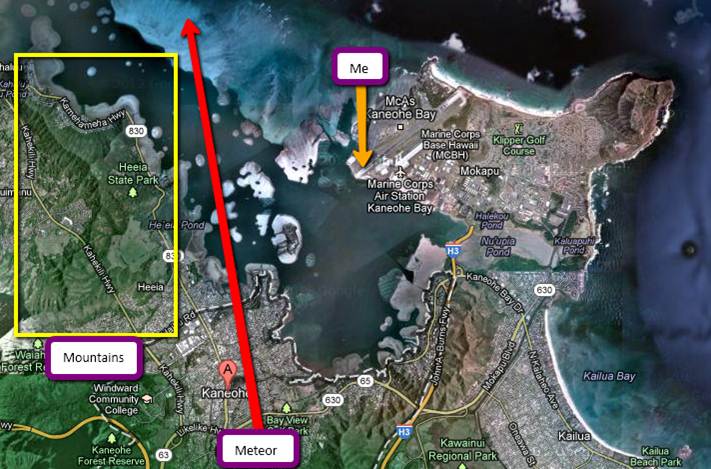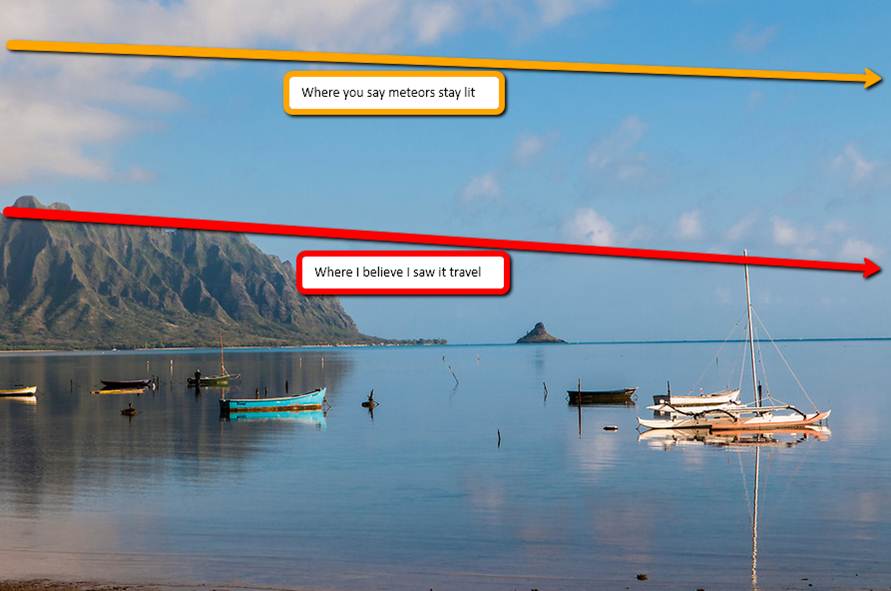It looks like you're using an Ad Blocker.
Please white-list or disable AboveTopSecret.com in your ad-blocking tool.
Thank you.
Some features of ATS will be disabled while you continue to use an ad-blocker.
share:
reply to post by FireballStorm
Thanks again for clarifying that information, you're obviously more well versed them I on this topic. So let me ask you, and I think this is still relevant to the OP, how did I *hear* the meteorite then?
I put together some photos that best represent my location; I remember that the meteor lit up the surrounding mountain ranges and *maybe* the mountains also echoed the burning sound? But, as you say, the meteor would have to be much higher for this to occur?

This photo is very close to my point of view at the time. Also, I was on duty as a military policeman patrolling the airfield around 3AM when I saw it. And it was spectacular.

And the trajectory, again from Kaneohe Bay, HI - and is accurate to my view.

Thanks.
Thanks again for clarifying that information, you're obviously more well versed them I on this topic. So let me ask you, and I think this is still relevant to the OP, how did I *hear* the meteorite then?
I put together some photos that best represent my location; I remember that the meteor lit up the surrounding mountain ranges and *maybe* the mountains also echoed the burning sound? But, as you say, the meteor would have to be much higher for this to occur?

This photo is very close to my point of view at the time. Also, I was on duty as a military policeman patrolling the airfield around 3AM when I saw it. And it was spectacular.

And the trajectory, again from Kaneohe Bay, HI - and is accurate to my view.

Thanks.
edit on 13-12-2012 by Jason88 because: (no reason given)
Originally posted by intrptr
Tell them what you told me one time how far a "shooting star" can travel in under a second. Might help to give some scale to sightings of fireballs by the "uninitiated".
I can't remember what I said... I do loose track a bit sometimes!
Either way, the slowest meteors which originate in our solar system will enter the atmosphere at a relative speed of about 10km/s. The average speed for meteors is around the 35km/s mark, and the faster ones are around 73km/s.
If you check google maps for familiar landmarks in your area that are in that kind of range of distance away from you, and think about how long you'd take to get there under normal circumstances, you can get a feel for how fast these objects are going. What would take you between 20 mins and 1.5 hrs to drive, a meteor would cover in a second.
It's primarily due to these extreme speeds, which translate directly into huge light output when the object enters the atmosphere, that meteors can be so bright - sometimes out-shining the Sun in brightness!
i have to say that 'booms' being attributed to meteors is, to me, a new (and entirely unbelievable) phenomenon. there's shenanigans afoot in our
skies. and on the ground.
reply to post by Jason88
You're welcome Jason.
This should answer your question regarding the sounds that you heard:
Source: The American Meteor Society Fireball FAQs
Here is some further reading on the subject: Global Electrophonic Fireball Survey
You're welcome Jason.
This should answer your question regarding the sounds that you heard:
There are two reported types of sounds generated by very bright fireballs, both of which are quite rare. These are sonic booms, and electrophonic sounds.
If a very bright fireball, usually greater than magnitude -8, penetrates to the stratosphere, below an altitude of about 50 km (30 miles), and explodes as a bolide, there is a chance that sonic booms may be heard on the ground below. This is more likely if the bolide occurs at an altitude angle of about 45 degrees or so for the observer, and is less likely if the bolide occurs overhead (although still possible) or near the horizon. Because sound travels quite slowly, at only about 20 km per minute, it will generally be 1.5 to 4 minutes after the visual explosion before any sonic boom can be heard. Observers who witness such spectacular events are encouraged to listen for a full 5 minutes after the fireball for potential sonic booms.
Another form of sound frequently reported with bright fireballs is “electrophonic” sound, which occurs coincidentally with the visible fireball. The reported sounds range from hissing static, to sizzling, to popping sounds. Often, the witness of such sounds is located near some metal object when the fireball occurs. Additionally, those with a large amount of hair seem to have a better chance of hearing these sounds. Electrophonic sounds have never been validated scientifically, and their origin is unknown. Currently, the most popular theory is the potential emission of VLF radio waves by the fireball, although this has yet to be verified.
Source: The American Meteor Society Fireball FAQs
Here is some further reading on the subject: Global Electrophonic Fireball Survey
Thats the North Korean satellite that was hit by our US airforce x plane.
No mystery-
Welcome to the 100% transparency world of intel. They watch us and we watch them so climb aboard and watch.
No mystery-
Welcome to the 100% transparency world of intel. They watch us and we watch them so climb aboard and watch.
Originally posted by RoScoLaz
i have to say that 'booms' being attributed to meteors is, to me, a new (and entirely unbelievable) phenomenon. there's shenanigans afoot in our skies. and on the ground.
Why shouldn't it be believable, considering the speeds meteors are capable of? If something breaks the sound barrier, you'll get a boom - it's as simple as that.
Weather you believe it or not, booms from large fireballs that penetrate deeply into the atmosphere are well documented by science, and have been known about for a long long time.
edit on 13-12-2012 by FireballStorm because: punctuation
Originally posted by FireballStorm
reply to post by Jason88
You're welcome Jason.
This should answer your question regarding the sounds that you heard:
There are two reported types of sounds generated by very bright fireballs, both of which are quite rare. These are sonic booms, and electrophonic sounds.
If a very bright fireball, usually greater than magnitude -8, penetrates to the stratosphere, below an altitude of about 50 km (30 miles), and explodes as a bolide, there is a chance that sonic booms may be heard on the ground below. This is more likely if the bolide occurs at an altitude angle of about 45 degrees or so for the observer, and is less likely if the bolide occurs overhead (although still possible) or near the horizon. Because sound travels quite slowly, at only about 20 km per minute, it will generally be 1.5 to 4 minutes after the visual explosion before any sonic boom can be heard. Observers who witness such spectacular events are encouraged to listen for a full 5 minutes after the fireball for potential sonic booms.
Another form of sound frequently reported with bright fireballs is “electrophonic” sound, which occurs coincidentally with the visible fireball. The reported sounds range from hissing static, to sizzling, to popping sounds. Often, the witness of such sounds is located near some metal object when the fireball occurs. Additionally, those with a large amount of hair seem to have a better chance of hearing these sounds. Electrophonic sounds have never been validated scientifically, and their origin is unknown. Currently, the most popular theory is the potential emission of VLF radio waves by the fireball, although this has yet to be verified.
Source: The American Meteor Society Fireball FAQs
Here is some further reading on the subject: Global Electrophonic Fireball Survey
Wow! It must have been a “electrophonic” sound though I can confidently qualify it as a crackling roar, like a fireplace or the audio of a forest fire. I guess I'm at loss for words, what I saw doesn't qualify in your description. Crackling, kinda; hissing static, no; popping sound, nope. A burning roar, yes.
More - I had very short hair then (military & all), and had parked my patrol car so was on foot with no large metal objects near me (in the hangers were loads of jets and helicopters so lots of metal a few hundred yards behind me).
I don't want to derail this thread, but I do believe my experience is relatable to what the Swedes saw and heard, and the similarities that can be drawn to meteorites.
I just listened to a number of YouTube "fire, burning" related videos and found this one - it's close to what I heard, but the meteor sound was deeper (I do remember all these years later because it was so spectacular, and I was in policeman-mode observing facts).
edit on 13-12-2012 by Jason88 because: (no reason given)
reply to post by Jason88
I wouldn't take those exact definitions too literally. Anything in that general area would qualify, and people always have slightly different descriptions for what they have heard. In my case, it sounded like bacon sizzling in a pan.
I've actually come across quite a few people reporting electrophonic fireballs here on ATS in my time here. It's probably a slightly more common phenomena than the current thinking says I would say.
I'd also keep in mind that, although we'd all like it not to be true, memory is a peculiar thing, and over time especially, memories get distorted.
I'd highly recommend reading this thread I authored, especially for the replies: How good are we at estimating the distance and altitude of UFOs?
I wouldn't take those exact definitions too literally. Anything in that general area would qualify, and people always have slightly different descriptions for what they have heard. In my case, it sounded like bacon sizzling in a pan.
I've actually come across quite a few people reporting electrophonic fireballs here on ATS in my time here. It's probably a slightly more common phenomena than the current thinking says I would say.
I'd also keep in mind that, although we'd all like it not to be true, memory is a peculiar thing, and over time especially, memories get distorted.
I'd highly recommend reading this thread I authored, especially for the replies: How good are we at estimating the distance and altitude of UFOs?
reply to post by FireballStorm
Thanks. I was amazed when you told me that the quick streaks we see overhead are ten, twenty even thirty miles long in just a moment! They are also high up in the atmosphere anywhere up to a couple hundred of miles...
Thanks. I was amazed when you told me that the quick streaks we see overhead are ten, twenty even thirty miles long in just a moment! They are also high up in the atmosphere anywhere up to a couple hundred of miles...
Corrected by next poster.
-SAP-
-SAP-
edit on 13-12-2012 by SloAnPainful because: (no reason given)
reply to post by Ear-Responsible
Aww gotcha. Yeah people on facebook were saying that too.
Thanks. Got a little excited
-SAP-
Aww gotcha. Yeah people on facebook were saying that too.
Thanks. Got a little excited
-SAP-
new topics
-
SETI chief says US has no evidence for alien technology. 'And we never have'
Aliens and UFOs: 1 hours ago -
This is our Story
General Entertainment: 4 hours ago -
President BIDEN Vows to Make Americans Pay More Federal Taxes in 2025 - Political Suicide.
2024 Elections: 6 hours ago -
Ode to Artemis
General Chit Chat: 7 hours ago -
Ditching physical money
History: 10 hours ago -
One Flame Throwing Robot Dog for Christmas Please!
Weaponry: 10 hours ago -
Don't take advantage of people just because it seems easy it will backfire
Rant: 11 hours ago -
VirginOfGrand says hello
Introductions: 11 hours ago
top topics
-
University student disciplined after saying veganism is wrong and gender fluidity is stupid
Education and Media: 14 hours ago, 14 flags -
Police clash with St George’s Day protesters at central London rally
Social Issues and Civil Unrest: 17 hours ago, 10 flags -
President BIDEN Vows to Make Americans Pay More Federal Taxes in 2025 - Political Suicide.
2024 Elections: 6 hours ago, 10 flags -
Should Biden Replace Harris With AOC On the 2024 Democrat Ticket?
2024 Elections: 12 hours ago, 6 flags -
One Flame Throwing Robot Dog for Christmas Please!
Weaponry: 10 hours ago, 6 flags -
Ditching physical money
History: 10 hours ago, 4 flags -
Don't take advantage of people just because it seems easy it will backfire
Rant: 11 hours ago, 4 flags -
God lived as a Devil Dog.
Short Stories: 16 hours ago, 3 flags -
SETI chief says US has no evidence for alien technology. 'And we never have'
Aliens and UFOs: 1 hours ago, 3 flags -
VirginOfGrand says hello
Introductions: 11 hours ago, 2 flags
active topics
-
Remember These Attacks When President Trump 2.0 Retribution-Justice Commences.
2024 Elections • 51 • : Justoneman -
British TV Presenter Refuses To Use Guest's Preferred Pronouns
Education and Media • 131 • : FlyersFan -
Spectrophilia - Women Who Have Had Affairs With Ghosts Say Spooks Are Better Lovers Than Real Men
Paranormal Studies • 30 • : FlyersFan -
Breaking Baltimore, ship brings down bridge, mass casualties
Other Current Events • 471 • : bally001 -
-@TH3WH17ERABB17- -Q- ---TIME TO SHOW THE WORLD--- -Part- --44--
Dissecting Disinformation • 639 • : Justoneman -
University student disciplined after saying veganism is wrong and gender fluidity is stupid
Education and Media • 31 • : KrustyKrab -
SETI chief says US has no evidence for alien technology. 'And we never have'
Aliens and UFOs • 8 • : 19Bones79 -
Republican Voters Against Trump
2024 Elections • 289 • : Justoneman -
The Acronym Game .. Pt.3
General Chit Chat • 7742 • : bally001 -
"We're All Hamas" Heard at Columbia University Protests
Social Issues and Civil Unrest • 264 • : HopeForTheFuture
